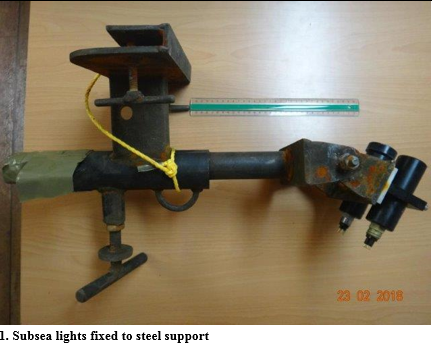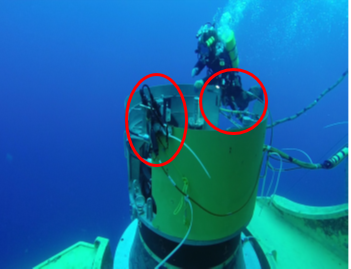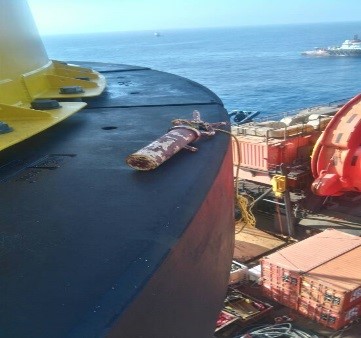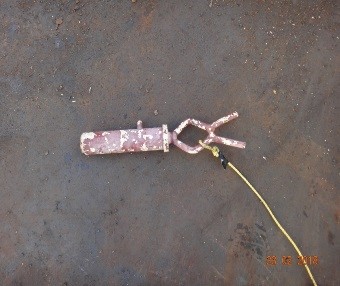Near miss: potential dropped objects on a temporary buoys (TBMs)
What happened?
A member has reported two near miss incidents involving potential dropped objects. The objects were left on top of a temporary buoyancy module (TBM) during the installation of a tension leg platform (TLP).
In the first incident, two subsea lamps (each weighing 10kg in the air) were discovered on top of the TBM after it was retrieved back to deck. In the second incident, during an inspection of the top of a TBM, also after it was retrieved back to deck, a rigging crew discovered a wire cable retaining pin (weighing 10kg in the air) lying loose on top of the upper bumper.
Incident 1 – Two temporary subsea lamps found on top of the TBM


What went wrong? What were the causes?
An investigation discovered that the lamps were temporarily fixed to the TBM by the diving team, and should have been removed after they had finished their task in accordance with their post installation dive tasks. All other subsea lamps used during the task had been removed.
- Not all subsea lamps were recovered as per post-installation dive tasks;
- The missing subsea lamps were not identified immediately;
- The company was unaware of the missing subsea lamps; there was no notification given by the subcontractor;
- There was no awareness of the possibility of loose equipment being left behind, causing a dropped object threat to the company lifting crew.
What actions were taken?
- Ensure that subcontractor personnel are properly reminded of the company procedures for subsea material recovery;
- Further emphasize to crew the importance of stop work authority and of speaking up when they see an unsafe condition – which in this case was found to be very effective.
Incident 2 – A wire cable retaining pin was found lying loose on top of the TBM


What went wrong? What were the causes?
Investigation discovered that the object was an ‘ROV friendly’ wire cable-retaining pin. The pin was used to retain a wire in a sheave from which a ball grab was suspended. In order to retrieve the ball grab, an ROV was used to remove the retaining pin. After removal of the pin, the ROV was to let go of the pin, which would then stay suspended under water hanging from a rope. As this pin was not lashed properly, it became loose and landed on top of the upper bumper.
- Inadequate lashing using inappropriate rope made it possible for the pin to drop;
- The importance of proper lashing was not acknowledged by the divers or the dive supervisor.
What actions would be taken?
- This incident would be circulated as a lesson learned.
Safety Event
Published: 4 June 2018
Download: IMCA SF 11/18
IMCA Safety Flashes
Submit a Report
IMCA Safety Flashes summarise key safety matters and incidents, allowing lessons to be more easily learnt for the benefit of all. The effectiveness of the IMCA Safety Flash system depends on Members sharing information and so avoiding repeat incidents. Please consider adding safetyreports@imca-int.com to your internal distribution list for safety alerts or manually submitting information on incidents you consider may be relevant. All information is anonymised or sanitised, as appropriate.
IMCA’s store terms and conditions (https://www.imca-int.com/legal-notices/terms/) apply to all downloads from IMCA’s website, including this document.
IMCA makes every effort to ensure the accuracy and reliability of the data contained in the documents it publishes, but IMCA shall not be liable for any guidance and/or recommendation and/or statement herein contained. The information contained in this document does not fulfil or replace any individual’s or Member's legal, regulatory or other duties or obligations in respect of their operations. Individuals and Members remain solely responsible for the safe, lawful and proper conduct of their operations.
